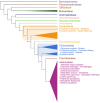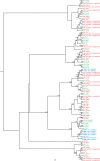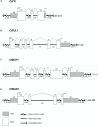A Vernalization Response in a Winter Safflower (Carthamus tinctorius) Involves the Upregulation of Homologs of FT, FUL, and MAF
- PMID: 33859660
- PMCID: PMC8043130
- DOI: 10.3389/fpls.2021.639014
A Vernalization Response in a Winter Safflower (Carthamus tinctorius) Involves the Upregulation of Homologs of FT, FUL, and MAF
Abstract
Safflower (Carthamus tinctorius) is a member of the Asteraceae family that is grown in temperate climates as an oil seed crop. Most commercially grown safflower varieties can be sown in late winter or early spring and flower rapidly in the absence of overwintering. There are winter-hardy safflower accessions that can be sown in autumn and survive over-wintering. Here, we show that a winter-hardy safflower possesses a vernalization response, whereby flowering is accelerated by exposing germinating seeds to prolonged cold. The impact of vernalization was quantitative, such that increasing the duration of cold treatment accelerated flowering to a greater extent, until the response was saturated after 2 weeks exposure to low-temperatures. To investigate the molecular-basis of the vernalization-response in safflower, transcriptome activity was compared and contrasted between vernalized versus non-vernalized plants, in both 'winter hardy' and 'spring' cultivars. These genome-wide expression analyses identified a small set of transcripts that are both differentially expressed following vernalization and that also have different expression levels in the spring versus winter safflowers. Four of these transcripts were quantitatively induced by vernalization in a winter hardy safflower but show high basal levels in spring safflower. Phylogenetic analyses confidently assigned that the nucleotide sequences of the four differentially expressed transcripts are related to FLOWERING LOCUS T (FT), FRUITFUL (FUL), and two genes within the MADS-like clade genes. Gene models were built for each of these sequences by assembling an improved safflower reference genome using PacBio-based long-read sequencing, covering 85% of the genome, with N50 at 594,000 bp in 3000 contigs. Possible evolutionary relationships between the vernalization response of safflower and those of other plants are discussed.
Keywords: PacBio; flowering time; genome; safflower; vernalization.
Copyright © 2021 Cullerne, Fjellheim, Spriggs, Eamens, Trevaskis and Wood.
Conflict of interest statement
The authors declare that the research was conducted in the absence of any commercial or financial relationships that could be construed as a potential conflict of interest.
Figures







Similar articles
-
Characterization of FLC, SOC1 and FT homologs in Eustoma grandiflorum: effects of vernalization and post-vernalization conditions on flowering and gene expression.Physiol Plant. 2011 Apr;141(4):383-93. doi: 10.1111/j.1399-3054.2011.01447.x. Epub 2011 Feb 8. Physiol Plant. 2011. PMID: 21241311
-
Vernalization-induced changes of the DNA methylation pattern in winter wheat.Genome. 2002 Apr;45(2):253-60. doi: 10.1139/g01-147. Genome. 2002. PMID: 11962622
-
Experiencing winter for spring flowering: A molecular epigenetic perspective on vernalization.J Integr Plant Biol. 2020 Jan;62(1):104-117. doi: 10.1111/jipb.12896. J Integr Plant Biol. 2020. PMID: 31829495 Review.
-
Non-vernalization Flowering and Seed Set of Cabbage Induced by Grafting Onto Radish Rootstocks.Front Plant Sci. 2019 Jan 10;9:1967. doi: 10.3389/fpls.2018.01967. eCollection 2018. Front Plant Sci. 2019. PMID: 30687362 Free PMC article.
-
The Diverse Roles of FLOWERING LOCUS C in Annual and Perennial Brassicaceae Species.Front Plant Sci. 2021 Feb 15;12:627258. doi: 10.3389/fpls.2021.627258. eCollection 2021. Front Plant Sci. 2021. PMID: 33679840 Free PMC article. Review.
Cited by
-
Flowering time runs hot and cold.Plant Physiol. 2022 Aug 29;190(1):5-18. doi: 10.1093/plphys/kiac111. Plant Physiol. 2022. PMID: 35274728 Free PMC article. Review.
-
Evolutionary Dynamics of FLC-like MADS-Box Genes in Brassicaceae.Plants (Basel). 2023 Sep 15;12(18):3281. doi: 10.3390/plants12183281. Plants (Basel). 2023. PMID: 37765445 Free PMC article.
-
Genome-Wide Analysis of the APETALA2/Ethylene-Responsive Factor Gene Family in Carthamus tinctorius L.Plant Direct. 2025 Jan 16;9(1):e70032. doi: 10.1002/pld3.70032. eCollection 2025 Jan. Plant Direct. 2025. PMID: 39822732 Free PMC article.
-
Identification and expression analysis of the MADS-box genes of Kentucky bluegrass during inflorescence development.Physiol Mol Biol Plants. 2022 Jul;28(7):1359-1374. doi: 10.1007/s12298-022-01216-1. Epub 2022 Aug 22. Physiol Mol Biol Plants. 2022. PMID: 36051235 Free PMC article.
-
Genome-wide association study of 23 flowering phenology traits and 4 floral agronomic traits in tree peony (Paeonia section Moutan DC.) reveals five genes known to regulate flowering time.Hortic Res. 2022 Dec 2;10(2):uhac263. doi: 10.1093/hr/uhac263. eCollection 2023 Feb. Hortic Res. 2022. PMID: 36793754 Free PMC article.
References
-
- Andrews S., Krueger F., Krueger C., Wingate S. (2012). FastQC. Babraham: Babraham Institute.
-
- Baloch D. M., Karow R. S., Marx E., Kling J. G., Witt M. D. (2003). Vernalization studies with Pacific Northwest wheat. Agron. J. 95 1201–1208. 10.2134/agronj2003.1201 - DOI
-
- Baskin J. M., Baskin C. C. (1989). Seed-germination ecophysiology of jeffersonia-diphylla, a perennial herb of mesic deciduous forests. Am. J. Bot. 76 1073–1080. 10.1002/j.1537-2197.1989.tb15088.x - DOI
LinkOut - more resources
Full Text Sources
Other Literature Sources

